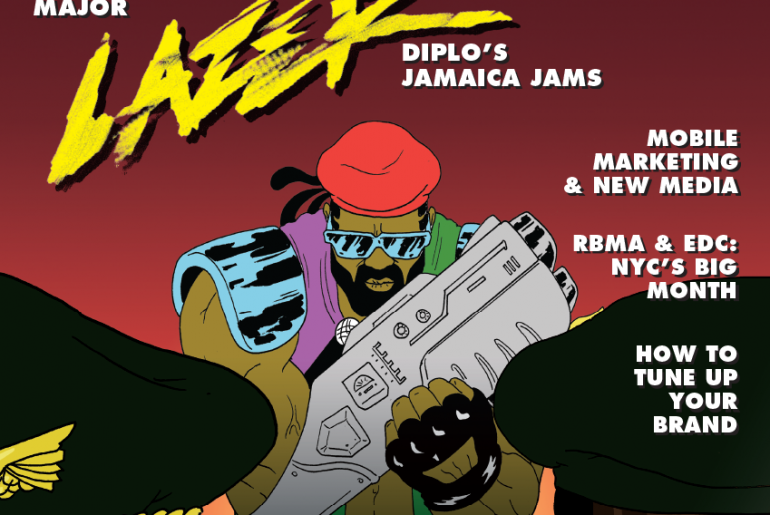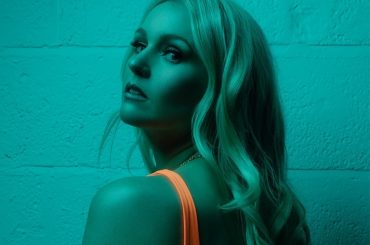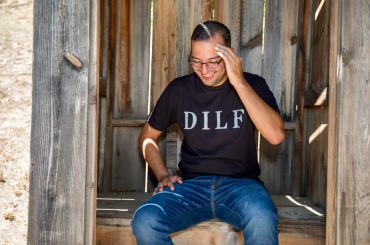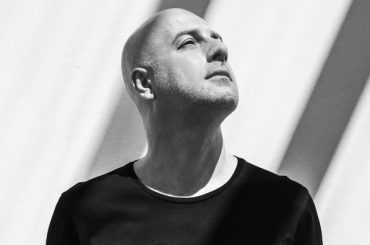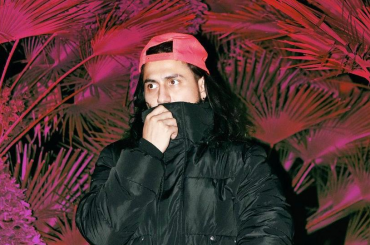Indio, Calif. – Just before 6 p.m. on the Saturday of this year’s Coachella Arts and Music Festival, the main stage area becomes almost deserted, as a large number of festival-goers migrate to the Mojave Tent on the far end of the venue. What’s all the fuss? Major Lazer is preparing to hit the stage.
And, as with all things these days, the ubiquitous DJ/producer’s reggae-fied project is enjoying its own level of notoriety in the lead up to America’s premier music festival. With a bumpin’ new album on the immediate horizon and a fresh new stage show promised, the buzz is tangible. And, lucky for the massive Coachella crowd, the current incarnation of Major Lazer—, DJ/producer Jillionaire, hype man Walshy Fire, and dancers Mela and Lafayette—does not disappoint.
Right away, the vibe becomes hedonistic. The sweaty crowd spills out of the tent’s sides, stretching to neighboring tents—which are really not that close. The audience gets a synchronized dance going, bobbing like it has been rehearsing for a month prior to the show.
The guys have their T-shirts twirling like scarves in an Arabic dance, while the girls are either bottomless or topless—at least in the conventional sense. No one is fully naked, but they’re veering in that direction. When Fire tells them to “go low,” they all do, getting on the ground like a legion of pre-schoolers. They quiver with the anticipation of getting the command to jump. When it comes, they all leap, in impressive unison. Ultimately, crowd-walks inside a big plastic ball—Flaming Lips-style.
This being the first of Coachella’s two consecutive weekends, Major Lazer’s latest album, Free the Universe (Secretly Canadian), hasn’t been released yet—it will hit the stores a few days later. Nonetheless, the hyper-aware crowd already knows all the songs. And the album’s namedropper-y list of collaborators makes you want to have a long scroll through ’s Blackberry contact list: Bruno Mars and Tyga (“Bubblebutt”); Wyclef Jean (“Reach For The Stars”); Vampire Weekend’s Ezra Koenig (“Jessica”); Santigold (“You’re No Good”); Peaches (“Scare Me”); Laidback Luke and Ms. Dynamite (“Sweat”); Flux Pavilion (“Jah No Partial”)—and that’s not the half of it.
Made without former ML studio collaborator Switch, Free the Universe is ’s love letter to Jamaica—one that picks up where ML’s 2009 debut, Guns Don’t Kill People…Lazers Do, and its much-sampled single “Pon de Floor” left off. Recorded wholly at studios in and around Kingston, the album wears its reggae and dancehall stripes proudly. It may not be a “dance record,” but there’s still a party going on.
And yes, it’s another artistic triumph for —aka 34-year-old Thomas Wesley Pentz—who’s made a career of them. After gaining notice as a prime musical promoter of Brazilian baile funk and hit-producer for international superstar M.I.A., kept it going by founding his deeply influential Mad Decent imprint and doing more high-profile studio work—for Beyoncé, Usher, and now Snoop Lion, Snoop Dogg’s reggae incarnation. (Plus, there was that national television ad for Blackberry.)
And it must be noted that Mad Decent has taken on a life of its own. Jeffree’s—its web-only subsidiary that gives away carefully curated singles and ultimately re-packages them for iTunes—gave us Baauer’s chart-topping “Harlem Shake,” the biggest YouTube sensation since “Gangham Style.” (According to , the omnipresent single helped put the label back in the black financially.) And this summer’s Mad Decent Block party will extend its reach to 13 cities with a line-up that includes Major Lazer, Dillon Francis, Baauer, and Flosstradamus.
So, as you can see, this Major Lazer project is another chapter in the story of a DJ who has put himself in a position to do just about anything he wants, artistically. What more can a DJ ask for, right?
So we did our best to catch up with Diplo to discuss Major Lazer and his other upcoming projects. But locking down Diplo long enough to have a few questions answered is no easy feat. The following Q&A is the result of: two rushed phone calls on the way to Los Angeles International Airport; three missed or unanswered calls from LA and Paris; one aborted call while sitting down to dinner in Amsterdam; another aborted call, while catching a ride to the venue in Amsterdam; and finally, a call 30 minutes before show time in Amsterdam. So, with all that in mind, here’s the one and only Diplo:
DJ Times: The reaction of the crowd at Coachella seemed almost trained.
Diplo: Most people don’t expect that. Kids are so up-to-date and smart with the music. Coachella is a great place for live shows. A lot of the side-stage music is great. Our music is diluted in dance music because it’s all the same thing and all the marketing goes to the headliners.
DJ Times: What are you using when you’re playing live?
Diplo: We use a video programmer of Cartridges on our iPad that we’re controlling. We use Traktor and assemble all the tracks so we can go crazy in between songs. We use a Native Instruments sampler and trigger all kinds of things like bombs. We use two CDJs with the Traktor and MIDI controllers and another CDJ with a USB to trigger extra sounds.
DJ Times: How are you dividing up the on-stage tasks?
Diplo: It’s a mix between me and Jillionaire, half and half. He DJs and I come in when I want to. It starts out with him DJing and me intro-ing the show. I bring on Major Lazer. I organize the crowd.
DJ Times: What are you using when you’re only DJing?
Diplo: I might use Serato. I might use a USB key. I use Traktor to do a solo set. The main reason I use Traktor is to have everything ready so I can switch up the DJ sets faster.
DJ Times: Going back awhile, what was the first system you spun on?
Diplo: It was Gemini turntables and mixer that had a small sampler on it. I kept selling it and buying it back again from the pawn shop. This is when I was 16 or 17 in Florida.
DJ Times: Who were some of the DJs that influenced you at the time?
Diplo: Definitely DJ Laz, one of the first DJs on the radio whose [club] shows I saw in South Florida. DJ Khaled—he was big in Orlando when I was there. Before he became a producer, he was a radio DJ. And there was a pirate-radio station with a DJ called White Dog, who was a white guy who sold mixtapes. Then there was another guy, System D-128, who came from my neighborhood, and I loved his stuff.
DJ Times: It sounds like radio DJs had a bigger impact on you than club DJs.
Diplo: The only club DJs I saw in Florida were DJ Shadow—loved his stuff—and DJ Icey. That’s all I knew. As a producer, DJ Premier, Plastikman, Attica Blues, and stuff on Mo’ Wax, a lot of U.K. stuff. Portishead was really big for me, and the RZA. All that stuff helped me get interested in production. I started producing my first music 12 years ago. I started taking it seriously as a job eight years ago.
DJ Times: You have a lot of specialized tracks in your DJ sets.
Diplo: It’s kind of like playing Tetris. Since we make everything from track records to straight dancehall to roots-reggae music, it’s like making mixtapes as a kid. As a DJ, you want to introduce brand-new things, be on top of your game, ahead of all the other DJs. As for things that people give you, hot new records and mixes along the way, for example, we play “Harlem Shake,” but we’ll mix in a dancehall version that we did. Like Macklemore, we use our own mix of it. We like to make our own mixes of hot, big records, like party squads. We want to play as much of our records. Ninety-percent of the set is our records or our remixes or dubplates of other people’s songs that we’ve done for our show, and the other 10-percent is songs we’ve done because it’s cool. There’s a couple of pieces that connect the whole set.
DJ Times: How does your set go down in Jamaica since it’s so Jamaican-based?
Diplo: We got a lot of songs that get a lot of airplay in Jamaica on the radio. We did two shows there. It was one of the craziest shows we’ve ever had—to this day.


